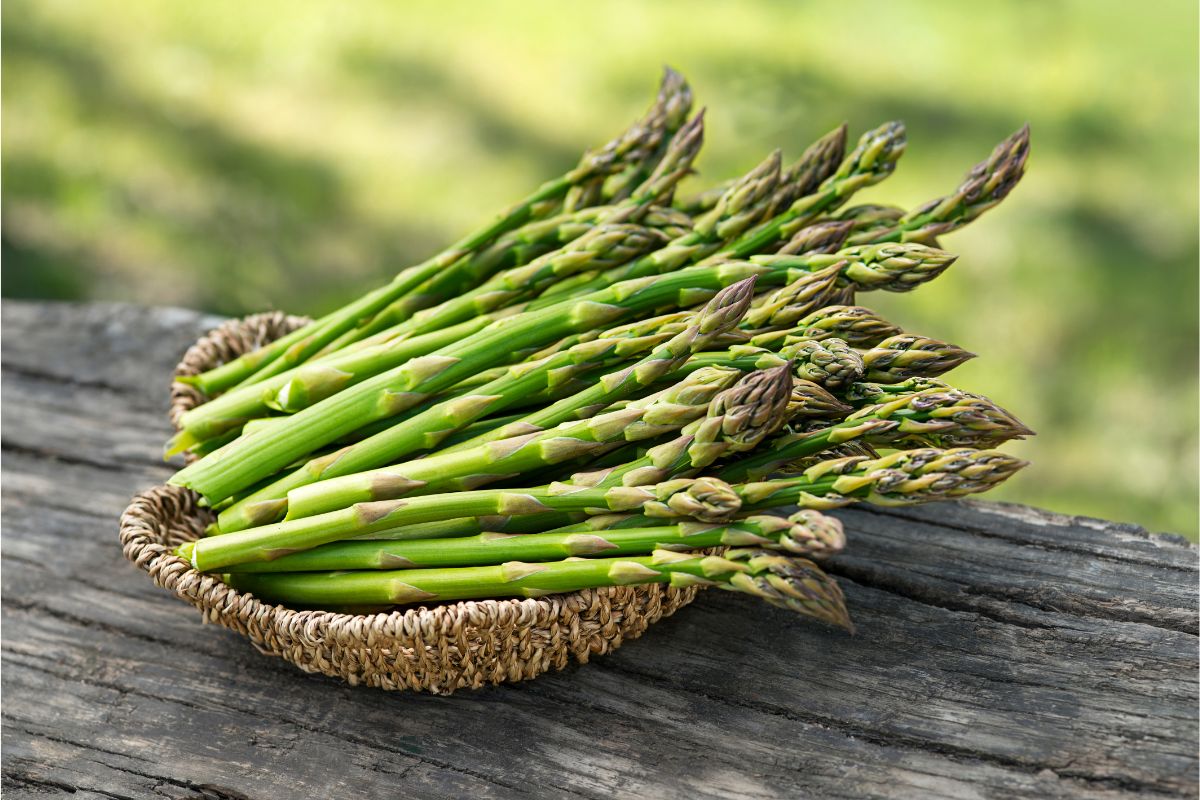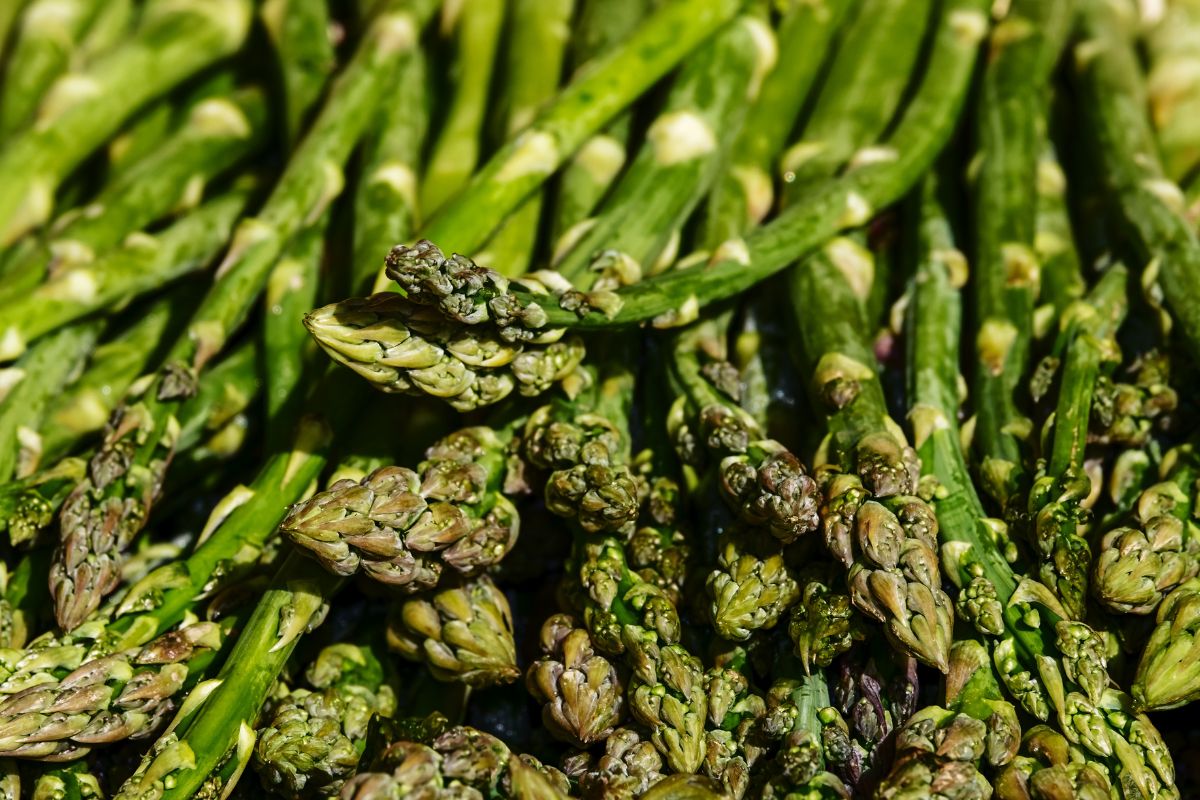Asparagus is a tasty vegetable with a slightly bitter flavor with a subtle hint of nuttiness. High in vitamin C and folate, asparagus is a healthy and flavorsome addition to a range of different recipes.

If you have purchased a bag of asparagus spears and forgotten about them in the fridge, you may be wondering how long they last. This guide will explore everything you need to know about expired asparagus, including how you can tell if it has gone off.
How Long Will Asparagus Last?
The length of time that raw asparagus lasts will depend on the storage method that you use. When kept in the fridge, fresh asparagus usually lasts for between 3 and 5 days.
However, you can extend the shelf life of the asparagus slightly by keeping it moist. For example, you can wrap the asparagus in a damp cloth so that it lasts for up to 7 days.
Alternatively, you can place the asparagus in a glass jar so that it can stay fresh for approximately 10 days.
To fully extend the use-by date of your asparagus, you can freeze it. When kept in a freezer, the asparagus could last for a maximum of 12 months.
You should not leave asparagus at room temperature for longer than 2 hours. This is especially important when it comes to cooked asparagus, as bacteria will begin to grow at these temperatures.
How Long Does Cooked Asparagus Last?
If you have leftover cooked asparagus, you will be glad to find out that you can keep it for a later date. Cooked asparagus will remain edible for between 3 and 5 days, the same as raw asparagus.
Cooked asparagus should be stored in the fridge to lock in the freshness. Additionally, it is recommended that you wrap the asparagus in foil to maximize its freshness.
How Can You Store Asparagus?
When it comes to storing asparagus, most people will simply opt for placing it in the fridge. While this is a decent way of storing the vegetable, as it will remain fresh for up to 5 days, other methods can be more beneficial.
Properly storing the asparagus is essential for keeping it fresh for as long as possible. There are a few different storage methods that you can use to ensure that this vegetable means fresh, such as:
Freezing
Freezing is perhaps the best method for lengthening the shelf life of asparagus. Though freezing is fairly simple, it is not as simple as it initially appears. To freeze asparagus, simply follow these steps:
- Firstly, you should prepare the asparagus. To do this, you should wash the vegetable under water and trim the spears. The asparagus spears can either remain whole or you can cut into smaller chunks depending on how you will use them.
- Before freezing the asparagus, you should blanche it. Essentially, this is the process of briefly exposing the food to scalding water to extend its freshness. To do this, you should place the asparagus into a pan and submerge it in boiling water.
- Blanch the asparagus for between 2 and 4 minutes.
- Carefully drain the asparagus to remove it from the boiling water. Attempt to get the asparagus as dry as possible during this stage.
- Then, you should put the vegetable into a bowl of icy water. Leave the asparagus to cool in this cold water for a few minutes, roughly the same amount as the time that it was in the boiling water.
- Take the asparagus out of the water and pat dry it with kitchen paper. Put the asparagus into freezer bags. When sealing the asparagus, try to remove as much air as possible. On these bags, write the date on a label so that you know how long you can keep the asparagus.
- Place the asparagus into the freezer. Use the vegetable within one year. You can either thaw the asparagus or cook it frozen.
Paper Towel
As mentioned, you can make the asparagus last for longer by keeping it in moist conditions. If you want to try this, complete these instructions:
- Submerge a paper towel in water. Alternatively, you could utilize a tea towel.
- Take the towel out of the water and wring out most of the excess moisture. The towel should be damp but not dripping with water.
- Grab the asparagus and wrap it in a damp towel.
- Then, transfer the towel and asparagus to a zip-top bag. Close the bag before placing it into the fridge, preferably into the crisper drawer.
Glass Jar
If you are not intending to use your asparagus immediately, you can store the asparagus by placing it in a glass jar. Akin to the method used for storing flowers, this technique allows the asparagus to stay suitably moist. The water will be absorbed so that the entire spear of asparagus can stay fresh.
To store your asparagus in a glass jar, all you have to do is:
- Cut the ends off the asparagus. This should be approximately 1 inch off the bottom of the spear. To save time, group the asparagus together with a rubber band. Then, chop off the ends with a sharp knife before discarding the ends. You can then remove this rubber band.
- Fill a glass jar or mug with cold water. Namely, you should provide approximately 1 inch of water.
- Place the asparagus into the mug or jar so that it is standing up. Ensure that the spears are facing upward so that just the base of this vegetable is dipped in water.
- Loosely cover the asparagus with a plastic bag.
- Put the glass of asparagus into your fridge. When using this method, the asparagus should stay fresh for around 5 days. If the water starts to turn cloudy, consider replacing this water.
How Can You Tell If Asparagus Is Bad?

Nobody wants to eat gone-off asparagus. Luckily, there are a few different signs that you can look out for to determine whether or not the asparagus has expired. Namely, you will need to review the texture, color, and scent of the asparagus.
Texture
In terms of texture, asparagus typically feels firm and crisp. However, this vegetable will start to soften over time. If the asparagus feels soft, this is a sign that it has started to expire.
If the asparagus is mushy or slimy, this will indicate that it has expired. Consequently, you should refrain from eating this asparagus, as it will not provide a pleasant eating experience.
You may also have noticed that the asparagus stalk has turned limp or shriveled. If so, this is yet another symptom of expired asparagus.
Color
Asparagus is known for its green hue. However, there are also purple and white varieties. When they have started to go off, asparagus will start to turn a shade of dark green or black toward the heads or tips.
If the vegetable has only started to turn dark green, you can likely continue to eat it. It is only once the vegetable has turned black that you may wish to refrain from eating it.
Scent
Generally, asparagus should not have a strong smell. Cooked asparagus may develop a slight odor, but it still should not have a pungent scent.
Unfortunately, the asparagus has likely gone bad if it has developed a strong odor. Expired asparagus should smell rather foul. If you notice this smell alongside some of the other indicators, the asparagus should be avoided.
Mold
The appearance of mold on fresh food is rarely a good sign. If you notice any fuzzy sections or black spots on the asparagus, this is a clear indication that it has exceeded its shelf life.
Some people will say that you can continue to eat moldy food so long as you cut off the affected area. Yet, it’s worth bearing in mind that the consumption of mold can lead to respiratory problems.
As a result, you should carefully consider whether it is worth eating the moldy asparagus.
Tips For Buying Asparagus
Buying high-quality asparagus is essential. After all, asparagus that has already started to expire will not last for very long after you have purchased it. To ensure that your asparagus is of good quality, pay attention to these simple tips:
- Make sure that the color of the asparagus has not faded. It’s worth bearing in mind that asparagus can come in a range of colors, including green, purple, and white.
- Ensure that the stem of the asparagus has a firm texture.
- It’s worth noting that asparagus can come in a variety of sizes. When you buy a pack of asparagus, you should endeavor to find a bunch that is roughly the same size. This will make preparing the asparagus much easier.
- It’s worth considering which type of asparagus is best suited to you. Green asparagus is the most popular and versatile. White asparagus is similar to green asparagus but is grown without direct sunlight. Yet, it is more expensive than green asparagus. Purple asparagus has a sweeter taste and is higher in antioxidants.
- Avoid asparagus with numerous blemishes.
Final Thoughts
Asparagus is an amazing addition to lots of delectable meals, including pasta and rice dishes. When using this tangy vegetable, it’s important to bear in mind that it has a short use-by-date.
Luckily, you can extend the lifespan of your asparagus by using some of the aforementioned storage techniques.
Frequently Asked Questions
Generally, we do not recommend that you eat food that has exceeded its use-by-date. On the other hand, if the asparagus has not developed any of the previously mentioned indicators of expiration, this will indicate that it is still fine to eat.
There are lots of different ways that you can use leftover asparagus. It will work wonderfully in egg dishes, such as quiches and omelets. Alternatively, you can bake leftover asparagus into a tart. It will also pair nicely with scrambled eggs or a salad.
Typically, asparagus can be boiled in just 5 minutes. Meanwhile, if you want to roast the asparagus, it should be ready in between 10 and 15 minutes.







